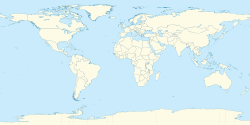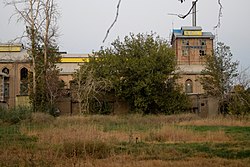world.wikisort.org - Iran
Varamin (/værɑːˈmɪn/; Persian: ورامين, also Romanized as Varāmīn and Verāmin)[2] is a city and capital of Varamin County, Tehran Province, Iran. At the 2011 census, its population was 218,991,[3] and at the 2006 census, its population was 208,569, in 53,639 families.[4]
| Year | Pop. | ±% |
|---|---|---|
| 1956 | 5,205 | — |
| 1966 | 11,183 | +114.9% |
| 1976 | 25,892 | +131.5% |
| 1986 | 58,311 | +125.2% |
| 1996 | 72,331 | +24.0% |
| 2006 | 208,569 | +188.4% |
| 2011 | 218,991 | +5.0% |
| [3] | ||
Varamin
ورامين | |
|---|---|
City | |
|
From top to bottom Courtyard of Jameh Mosque of Varamin، Imamzadeh Yahya، Aladdin Tower، Sugar factory | |
 Varamin Location in Iran  Varamin Varamin (Asia)  Varamin Varamin (Earth) | |
| Coordinates: 35°19′27″N 51°38′45″E | |
| Country | |
| Province | Tehran |
| County | Varamin |
| Bakhsh | Central |
| Population (2016 Census) | |
| • Urban | 225,628 [1] |
| Time zone | UTC+3:30 (IRST) |
| • Summer (DST) | UTC+4:30 (IRDT) |
| Area code | 021 (Formerly 0291) |
Etymology
The word "Varamin" has been recorded with the same spelling and pronunciation in Perso-arabic script since 3rd A.H. century.[5] While its etymology is not clear, there have been many speculations which are almost all not more than guesses. The entry "Varām" in Burhan-i Qati is defined as:"... Things that are easy and light, and a city in Mulk-i Rayy that is known also as Varāmin."[6]
The name has been transliterated in Latin scripts in many ways; such as Veramin,[2] Veramine,[7] Weramin, Weramine, Veraumin, and other variants, while Encyclopedia Iranica uses Varāmīn.[8]
History
Until 1220s, Varamin was an agricultural center of Ray. The raiding of Ray by the invading Mongols caused a flux of migration and economical growth during Mongol Ilkhanid rule. Thus, Varamin developed into an urban center. A Vizier of Ilkhanid Abu Sa'id, named Yusuf Quhadhi built the Jameh Mosque of Varamin. Other significant monuments from this era, include mausoleum of Imamzadeh Yahya, Aladdin Tower, Imamzadeh Shah Husayn, and Sharif mosque. At the turn of 14th century, Varamin started to decline due to Timurid Empire armies' invasions. In 1405, Ruy González de Clavijo described the city as mostly deserted, although during early Timurid rule, a minor restoration was applied to the Jameh mosque and Imamzadeh Hosein Reza was built. By 16th century, Tehran started to grow as the major city of the region.[9]
Landmarks
Ilkhanid architecture
During the Mongol Ilkhanate, as a result of the economic growth in the region, Varamin became an urban center and most of the significant historical monuments of this city belong to this period. Including:
Jameh mosque
The most famous building of the city, the Jameh mosque's construction began during Öljaitü's reign and completed in during his son's rule in 1322.[9]
Aladdin tower
A cylindrical tomb with a conic dome was built in 1289 over a local ruler's grave.
Imamzadeh Yahya
The tomb of a descendant of the Muhammad in the city, famed for its tile-works.[10] The tomb was constructed in 1307.
Others
Other than the three mentioned above, another tomb known as Shah Hoseyn was also built in Ilkhanid era. Portal of Masjid-i Sharif, which does not exist nowadays is mentioned to be completed in 1307.[9] An Ilkhanid graveyard was unearthed in 2016.[11]
Other sites
Other than above buildings, mausoleums of Hosein Reza, Sakinehbanu, Kowkab a-ddin, Seyyed Fathollah, and Zaid Abolhassan are other historical monuments. Additionally, historians have mentioned the Razaviyeh historical madrasah adjacent to the Jameh Mosque, also Varamin Castle, 1500 feet from the Jameh Mosque, has also been a noted by travelers, both the madrasah and citadel do not also exist today.[12]
Industries
Sugar refinery factory
Varamin Sugar Refinery Factory was built in 1934–1935 by Nikolai Markov and is the very first sugar refinery factory in Iran and Middle East. Since 2007 and privatization,[13] its produce has been reduced because of shortage in ingredients.[14][15]
Oil-extracting factory
Varamin Oil-extracting factory was built in 1938–1939 and is the first producer of vegetable oil in Iran.[16]
Handcrafts
Carpets and rugs
Carpets and rugs of Varamin are among most famous carpets in the world. Many rug and carpet experts see Varamins as purer Persian carpets.[17] They have geometric patterns with repeated medallions, especially on runners. They are made by tribal people who either live in or pass by Varamin.
Colleges and universities
Islamic Azad University
Islamic Azad University Varamin-Pishva Branch was established in 1985. This branch has more than 86 different majors and capacity of 15,000 students.[18]
Climate
| Climate data for Varamin | |||||||||||||
|---|---|---|---|---|---|---|---|---|---|---|---|---|---|
| Month | Jan | Feb | Mar | Apr | May | Jun | Jul | Aug | Sep | Oct | Nov | Dec | Year |
| Average high °C (°F) | 11 (52) |
13 (55) |
19 (66) |
25 (77) |
31 (88) |
37 (99) |
40 (104) |
38 (100) |
35 (95) |
26 (79) |
17 (63) |
13 (55) |
25 (78) |
| Average low °C (°F) | 3 (37) |
5 (41) |
10 (50) |
15 (59) |
20 (68) |
26 (79) |
28 (82) |
27 (81) |
23 (73) |
16 (61) |
9 (48) |
5 (41) |
16 (60) |
| Average precipitation mm (inches) | — | 30.40 (1.20) |
34.49 (1.36) |
38.80 (1.53) |
35.53 (1.40) |
9.40 (0.37) |
5.61 (0.22) |
2.60 (0.10) |
3.11 (0.12) |
21.44 (0.84) |
33.94 (1.34) |
17.41 (0.69) |
— |
| Average rainy days | 1 | 2 | 2 | 2 | 1 | 0 | 0 | 0 | 0 | 1 | 2 | 1 | 12 |
| Average relative humidity (%) | 42 | 42 | 33 | 29 | 23 | 15 | 15 | 17 | 18 | 27 | 41 | 45 | 29 |
| Source: World Weather Online[19] | |||||||||||||
References
- "Statistical Center of Iran > Home".
- Varamin can be found at GEOnet Names Server, at this link, by opening the Advanced Search box, entering "-3088133" in the "Unique Feature Id" form, and clicking on "Search Database".
- "Census of the Islamic Republic of Iran, 1390 (2011)". Islamic Republic of Iran. Archived from the original (Excel) on 2016-10-06.
- "Census of the Islamic Republic of Iran, 1385 (2006)" (Excel). Statistical Center of Iran. Archived from the original on 2011-11-11.
- Tājīk, ʻAlī Riz̤ā; Atrī, Siyyidizahrā (2005). Ās̲ār-i tārīkhī-i Varāmīn-i bāstān (in Persian) (Chāp-i 1 ed.). Tihrān: Mihr-i Amīr al-Muʼminīn. ISBN 9789648173833.
- Amini, Mohammad; Rezvan, Homayun (2003). Tarikh-e Ejtemai-e Varamin. Tehran: Elmi Farhangi Saheb-az-zaman. p. 88. ISBN 9640612278.
- Dieulafoy, Jane (2010). Une amazone en Orient du Caucase à Persépolis, 1881-1882. Paris: Phébus. ISBN 9782752904485.
- "EMĀMZĀDA iii. Number, distribution, and important examples". Encyclopedia Iranica. Retrieved 31 May 2022.
- Bloom, Jonathan; Blair, Sheila (2009). Grove Encyclopedia of Islamic Art & Architecture: Three-Volume Set. Oxford: Oxford University Press. p. 391. ISBN 9780195373042.
- Museum, Victoria and Albert. "Tile Panel | Ali ibn Muhammad ibn Abi Tahir | V&A Explore The Collections". Victoria and Albert Museum: Explore the Collections. Retrieved 9 June 2022.
- "كشف یك گورستان تاریخی در ورامین". ایرنا (in Persian). 7 August 2016. Retrieved 9 June 2022.
- "معنی جامع ورامین | لغتنامه دهخدا". www.vajehyab.com (in Persian). Retrieved 9 June 2022.
- "کارخانه قند ورامین در آستانه بازگشایی قرار گرفت" (in Persian). IRNA. Retrieved 10 February 2022.
- قديمي ترين کارخانه قند ايران تعطيل شد.. www.Parsine.com (in Persian).
- یادگارهای جناب نیکلای. www.Tebyan.net (in Persian).
- روغنکشی شماره ی یک ورامین. www.Khoec.com (in Persian). Archived from the original on 2011-10-01. Retrieved 2012-04-08.
- "Varamin carpets in Little Persia". www.little-persia.com.
- iauvaramin.ac.ir
- "Varamin Climate Weather Averages". WorldWeatherOnline.com. Retrieved 31 May 2022.
External links
Monuments
- Photographs of monuments in a Varāmin (these photographs are available on flickr):
- — Part of the exterior of Masjed-e Jāme'eh Varāmin: (1).
- — The interior of Masjed-e Jāme'eh Varāmin: (1)
На других языках
[de] Waramin
Waramin (persisch ورامين Varāmīn, DMG Warāmin) ist eine Großstadt in der Provinz Teheran.- [en] Varamin
[ru] Варамин
Варамин (перс. ورامین) — город на севере Ирана в провинции Тегеран, административный центр шахрестана Варамин. Население — 208 569 человек[1]. Расположен в 35 км на юго-запад от Тегерана. Железнодорожная станция на линии Тегеран — Мешхед.Другой контент может иметь иную лицензию. Перед использованием материалов сайта WikiSort.org внимательно изучите правила лицензирования конкретных элементов наполнения сайта.
WikiSort.org - проект по пересортировке и дополнению контента Википедии











